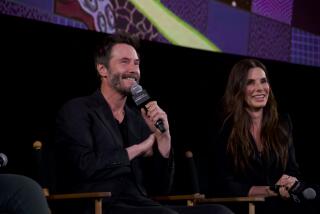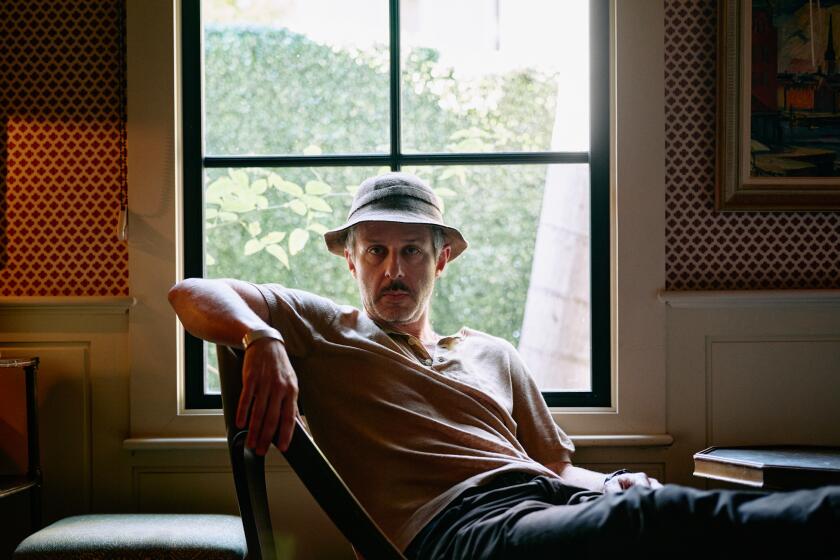An Imaginary Squirrel? Theater Veteran Wasn’t Fazed
Movies are supposed to be about make-believe, but this was ridiculous: At one point in the filming of the new feature “The Adventures of Rocky and Bullwinkle,” Des McAnuff, megaphone in hand like some silent-screen director from the 1920s, was trying to get 500 extras to follow the dizzying flight path--the swooping, diving, head-skimming trajectory--of a flying squirrel. A nonexistent flying squirrel.
“There was nothing there, there were just a bunch of shouted instructions. That was unique,” recalled McAnuff, a Tony-winning stage director whose experiences manning such complex theatrical efforts as “The Who’s Tommy” and “Big River” never quite prepared him for that D.W. Griffith moment as director of “The Adventures of Rocky and Bullwinkle.”
But such were the demands of the film, which combines live action and animation. The movie, which opens nationwide today, is based on the 1959-64 TV cartoon series about Rocky the flying squirrel, his dim-witted pal Bullwinkle the moose, their nemeses, the nefarious (though blessedly inept) Iron Curtain types Boris Badenov and Natasha Fatale, and other characters at once wonderfully silly and drolly satirical.
The movie version features Jason Alexander as Boris, Rene Russo as Natasha and Robert De Niro (whose Tribeca production company was partnered with Universal Pictures in making the film) as the criminal mastermind Fearless Leader. The title duo are the animated creations of Industrial Light & Magic.
Commanding all those live extras--who play students and administrators at Bullwinkle’s alma mater, Wossamotta U--to react to the imaginary Rocky (whose antics were later added through special effects) was definitely one of the more unusual challenges for a stage director like McAnuff. Generally, the shift from stage to screen is not quite that extreme, says the director, who made his feature film debut with 1998’s “Cousin Bette.”
In fact, in recent years, several high-profile theatrical directors, lured perhaps by the added challenge, the more widespread fame and the eventual possibility of greater financial rewards, have added film to their resumes. Most notably, Sam Mendes, who brought the smash revival of “Cabaret” to Broadway, hit the celluloid jackpot with his Oscar-winning direction of “American Beauty.” And Julie Taymor, most celebrated for her brilliantly inventive staging of “The Lion King,” moved to film with last year’s less-acclaimed “Titus.”
They’re joined by McAnuff, who was known as an audacious young director with experimental leanings before he became artistic director of the La Jolla Playhouse in 1983. There, his risk-taking approach, alternating classics and new plays with musicals (some of which went on to Broadway), turned La Jolla into one of the most respected regional theaters in the country. In 1993, though, he announced he was stepping down to try his hand at filmmaking.
“It’s a chance to reach a wide audience,” McAnuff said of his decision. “Also, one of the things you have to learn when you’re directing stage work is that because it exists in real time, you really can’t actually control it. You’re creating signposts, but the bottom line is, opening night when you sit there, or at any performance, it’s something that happens between the actors and the audience.”
By contrast with the day-to-day vagaries of theater, he notes, film offers a director much more control over the final product: “When you actually choose the shot, that shot is always going to be there.” In fact, he said, “you could argue that production, the filming part of the process, in a sense is gathering raw material. You’re going to make another movie in post-production,” when the final shots and all the other elements are selected and interwoven.
The differences between theater and the movies mean a different approach to working with actors, McAnuff says. So what approach do you take, even when you don’t have a cartoon squirrel or moose to worry about?
“On stage, with actors, you have weeks and weeks to prepare for the performance process,” he said. During rehearsals, “you want them to have something they can depend on so they can hit that moment night after night.”
But “with film, when that camera clicks on, it’s opening night for that actor, and you have to get it only once. So you don’t want to straitjacket that actor and get caught in a stale moment. You want spontaneity, for the work to be fresh and alive, and for the actors to have a strong sense of ownership.”
Of course, unlike most theater productions, the actors, and indeed everyone, in a film are usually working out of sequence. This means the movie’s director has to have a very strong sense of the continuity of the story. “That has to be very firmly in your head,” said McAnuff. “In preparation for this movie, I did something like 4,000 storyboard panels” in order, starting with the first scene and ending with the last. “So I had sketched the movie out in some detail before we even did a shot,” he explained. “That is the real key to it.”
Especially, it would seem, when you’ve got to convince 500 people that this is the absolute, precise moment when they should be mowed down by an imaginary, dive-bombing squirrel.
More to Read
Only good movies
Get the Indie Focus newsletter, Mark Olsen's weekly guide to the world of cinema.
You may occasionally receive promotional content from the Los Angeles Times.









